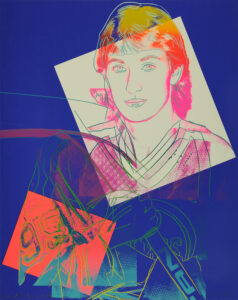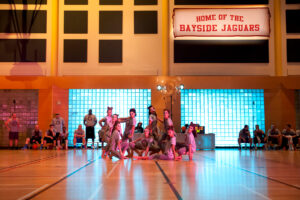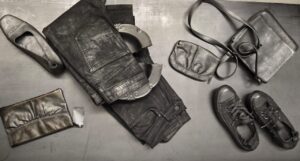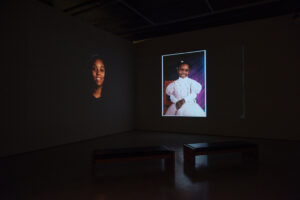- Home
- Exhibitions + Displays
- Last Look
Last Look
April 3, 2024 - May 26, 2024
Second Floor

Last Look is an opportunity to view select works that have been deaccessioned from AWE’s collection. From out of the vault, into the gallery for one last time, these works will soon be removed from AWE’s collection as they are out of scope of AWE’s collections focus on visual arts production in Canada. Other works—such as Andy Warhol’s Wayne Gretzky—are held in duplicate, and a second copy is not required.
The majority of works on view in this room are currently being offered to colleague institutions by sale, trade or donation, meaning that many of these objects will remain in public collections, often in this region. However, select works—including one edition of Andy Warhol’s Wayne Gretzky and Paul Kane’s Party of Indians in Two Canoes on Mountain Lake—will be offered at public auction through Canadian auction house Cowley Abbott in Toronto. Proceeds from this sale will be used to create a restricted endowment fund to support collections care and diversification.
For more information on the creation of this new endowment, please see the press release. For more information on deaccessioning, please see below.
Deaccessioning Frequently Asked Questions
WHY IS AN ENDOWMENT FUND FOR NEW ACQUISITIONS IMPORTANT?
Simply put, AWE cannot achieve the goal of diversifying our collection holdings if we are relying on donations.
When institutions like AWE rely on private collectors to build a public collection, it means that we are responding to specific donation opportunities rather than choosing artworks from an open market. While private collectors are beginning to collect more artwork by diverse artists, the commercial art market tends to lag behind public art galleries in promoting the work of diverse artists. By purchasing work directly from artists and their galleries, AWE is doing our part to build a sustainable and equitable arts ecosystem in our region and beyond.
WHAT IS DEACCESSIONING?
Deaccessioning is the process of removing a work of art from a museum’s permanent collection. The museum continues to legally own the work after it has been deaccessioned until the work is disposed of through select methods (see below). Regular deaccessioning is best practice in collections management and allows museums to refine their holdings and ensure the highest standards of collections care and display are maintained.
HOW ARE WORKS SELECTED FOR DEACCESSIONING? WHO DECIDES?
Deaccessioning is driven by institutional policy and industry best practices.1 Our approach is led by AWE’s Board-Governed Institutional Policies Manual, in particular our Curatorial Policies (3.iii.a). A work is considered for deaccessioning if:
- it is irrelevant to the Collection;
- it is of poor quality and beyond restoration;
- it is a duplicate in the Collection (i.e. prints);
- it is a copy, forgery, or reproduction of no documentary or archival value;
- it is under-used;
- it poses a potential health and safety risk;
- it is revealed that the institution does not legally own the object;
- the gallery is unable to properly store or maintain it.
Works shortlisted and ratified by AWE’s Executive Director for deaccessioning are presented to the External Affairs Committee and then to the Board of Directors for review. The External Affairs committee review the works, deaccession rationales prepared by AWE staff, and recommended disposal methods, and makes a recommendation to the Board. The Board reviews the Committee recommendation and the work undertaken by staff to support the deaccession, and makes a final decision, via a Board motion, on how to proceed.
DOES THE VALUE OF AN ARTWORK FACTOR INTO THE DECISION TO DEACCESSION?
No. Works are not selected for deaccessioning based on their value. However, the value of a deaccessioned work can be a factor in how it is handled after deaccessioning. AWE’s most recent deaccession strategy includes the decision to sell some works by public auction and to transfer other works to colleague institutions.
HOW ARE WORKS DISPERSED?
Works can be disposed of in one of the following ways:
- Transfer/sale at fair market value to other public institutions
- Transfer as donation to other public institutions
- Public sale through reputable vendors or at auction
- In very rare cases (i.e. for works with significant conservation concerns or that pose health risks) works may be permanently destroyed
Donors of works selected to be disposed via auction are individually notified to let them know of our decision. All efforts are made to ensure that the donors’ generosity continues to be recognized in a tangible, public way.
The public will also be made aware of all works being deaccessioned, with select works being displayed in a “final look” exhibition for viewing.
IF WORKS ARE SOLD, WHERE DOES THE MONEY GO?
The Canadian Museums Association has strict guidelines on deaccessioning, including how funds raised from deaccessioning might be used. In line with industry best practices, AWE will use all proceeds from deaccessioning for acquisitions and direct collections care. Proceeds will be placed in a restricted endowment fund, with the interest used to support collections care and diversification, in line with AWE’s Board-Governed Policies. AWE’s audited annual statements will include reporting on this restricted endowment fund. Audited statements are presented at AWE’s Annual General Meeting and are made publicly available on our website afterwards.
WHY DOES AWE HOLD WORKS OUTSIDE ITS COLLECTING MANDATE?
Many institutions undergo significant changes throughout their lifetimes. Professional practices within a field also change significantly over time. When AWE first opened, we were in a historic house and our collection included many items we no longer collect today, including furniture and decorative objects. As the gallery has matured, our mandate has developed accordingly and some of these items no longer align with AWE’s mission or objectives.
AWE remains enormously grateful to the community members who have donated objects and artworks to our collection, even if those items no longer fit within our collections scope. We feel that the original intention of these donors is not served by keeping these items hidden within our vaults. By removing these items and making them available for sale, AWE is raising funds for a restricted endowment fund to support new purchases to reflect our mission and mandate, and the future needs of AWE’s audiences. These new acquisitions will help strengthen the collection. They will also allow the original donors’ legacies to manifest in different ways over a longer time.
HOW WILL AWE RECOGNIZE THE DONORS OF DEACCESSIONED ITEMS?
AWE will work with impacted donors to ensure that the credit lines for deaccessioned works are transferred to new artworks purchased with deaccessioning funds.
HAS AWE DEACCESSIONED WORKS BEFORE?
Yes. AWE has previously deaccessioned works from the collection that do not align with collecting mandates. Approximately 350 works have been deaccessioned throughout AWE’s history, with many pieces being disposed through public auctions. The last large deaccession occurred in the 1980s.
FURTHER RESOURCES:
- Gerrard, Richard. “An Introduction to the Deaccession and Disposal of Collections.” Ontario Museum Association, May 29, 2013. https://members.museumsontario.ca/sites/default/files/members/AnIntroductionToTheDeaccessionAndDisposalOfCollections29May2013.pdf
- Deaccessioning After 2020. Syracuse University Museum Studies Symposium. 30 April 2021. https://vpa.syr.edu/deaccessioning-after-2020/





